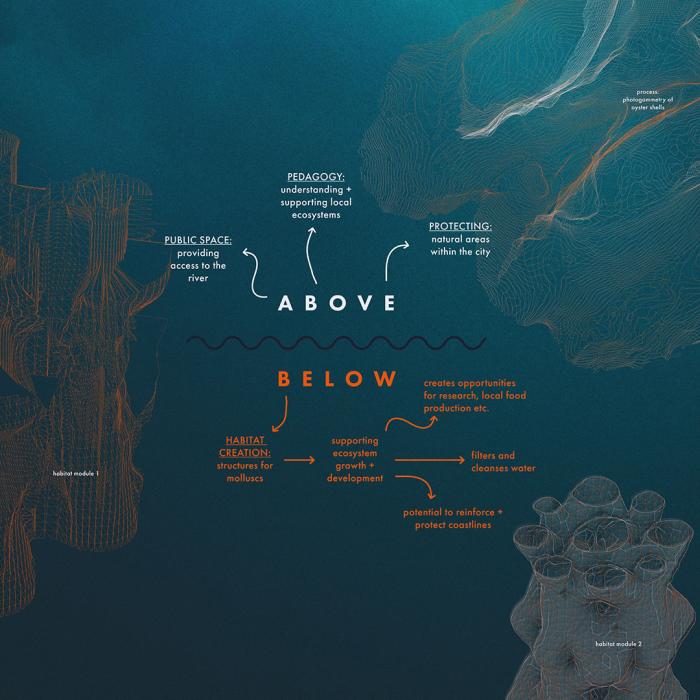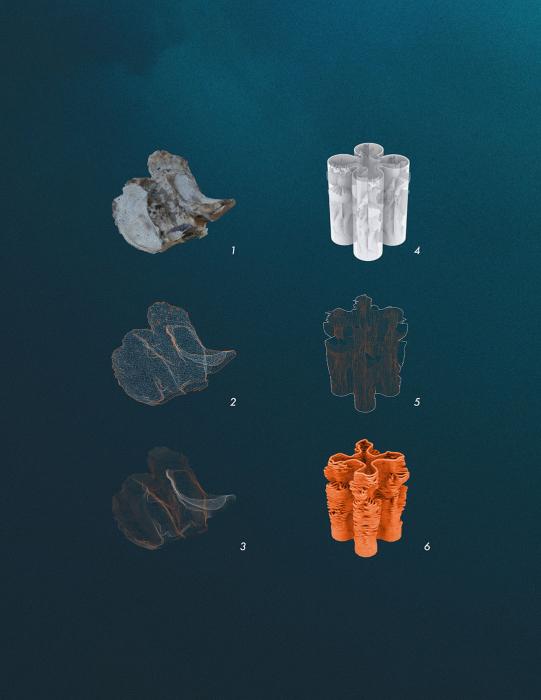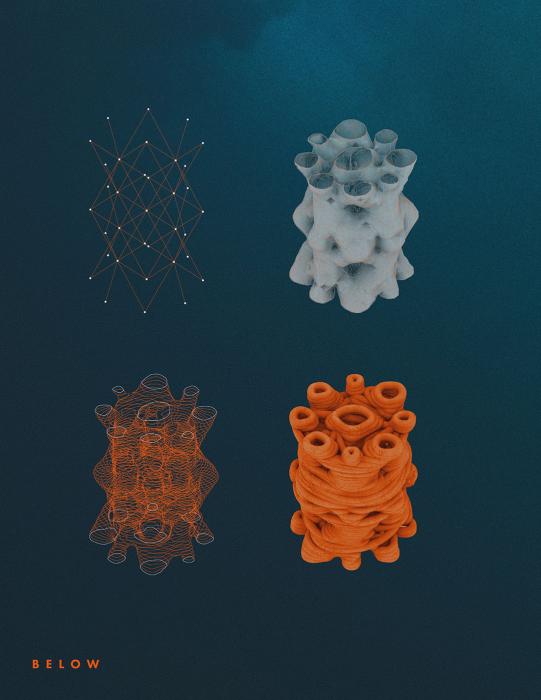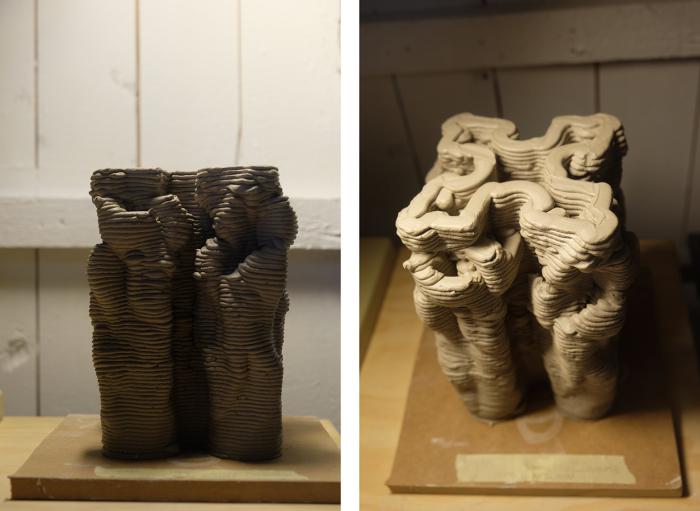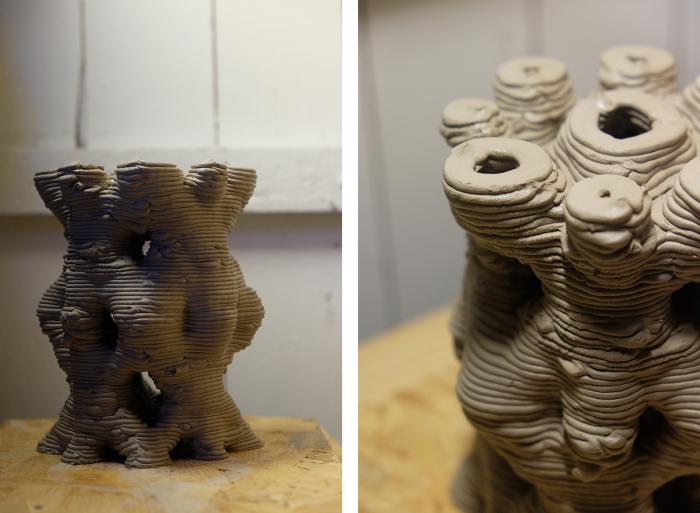I. SUMMARY INFORMATION
Project
268978
Status
Submitted
Award category
Interdisciplinary education models
You want to submit
NEW EUROPEAN BAUHAUS RISING STARS : concepts or ideas submitted by young talents (aged 30 or less)
Project title
Above/Below
Full concept/idea title
Above/Below
Description
‘Above/ /Below’ is a project which aims to revive ecologically rich areas within the city of Gothenburg by creating unique yet integrally linked space above and below the river’s surface. ‘Above’ we focus on public space, pedagogy and protection to connect Gothenburgers to their local ecosystem. ‘Below’ we’re creating 3D printed clay habitat modules to increase biodiversity, with a focus on blue mussels (mytilus edulis) - a species which filters water and creates habitats for other species.
Where is your concept/idea being developed or intended to be implemented in the EU?
Sweden
Västra Götaland
Bananapiren, Frihamnen
57°42'53.2"N
11°57'49.1"E
Göteborg
417 55
II. DESCRIPTION OF THE PROJECT
Please provide a summary of your concept/ idea
’Above/ /Below’ (A/B) finds its genesis in twin ecological and social issues connecting the people and the marine environment in Gothenburg, the ‘River City’. Firstly, we see ecological degradation within the Gothenburg branch of the Göta Älv due to the city’s historical industrialisation and ongoing activities as a shipping centre for Scandinavia. Secondly, while the Göta Älv is a defining aspect of Gothenburg’s geography and identity, it lacks public areas for residents to gather making the river largely inaccessible.
In response to these twin issues, we are working with an intervention which simultaneously creates opportunities for public activation and community engagement by the water and while rebuilding and caring for the fragile ecosystem that exists below the water. For this, we focus on blue mussels, Mytilus edulis (ME) for their ability to clean water and provide habitats for other species. They are a keystone species.
A/B creates unique yet integrally linked space “Above” and ”Below” the river’s surface. “Above” we focus on public space, pedagogy and protection. A temporary public space creates opportunities for people to gather, learn about their local ecosystem and be involved in ecological stewardship of their Götaälv. “Below” we create habitat structures for ME, which in turn create habitat opportunities for other species and lead to increased ecosystem resilience. We believe engaging with, educating, and connecting the public to local ecologically rich areas is integral to the success and longevity of sustainable development and habitat restoration programs.
We will work on Banana Pier in Frihamnen and have permission from the landowners, Älvstranden Utveckling. Previous pilot projects conducted here have demonstrated the existence and growth of blue mussels. Frihamnen is a perfect site for our project as it is generally understood as an ‘empty’ site with other experimental projects exploring transformation of post-industrial areas into publ
Please give information about the key objectives of your concept/idea in terms of sustainability and how these would be met
Ecological destruction and biodiversity loss in areas exploited by anthropogenic activities is a common global crisis, and sits within the framework of sustainability targets for both the fields of architecture and marine science. Thus, A/B, which weaves public engagement and involvement together with ecological stewardship and regeneration.
An important aspect of the A/B project is to focus on blue mussels, Mytilus edulis (ME) for their ecological value as a keystone species within the project area’s ecosystem. ME supports benthic ecosystems both through their ecosystem engineering traits, whereby they support an increase in biodiversity by increasing habitat complexity, and by their ability to filter water, thereby reducing eutrophication and improving water quality. Consequently, in the polluted waters around our post-industrial site in Frihamnen, the successful propagation of ME could result in improved water quality and opportunities for ecosystem restoration and resilience.
Improving water quality, reducing toxicity and revitalising natural areas within the city can also provide opportunities for healthy and pedagogical public space which focuses on connecting inhabitants to their local areas and developing local habitat literacy. We believe engaging with, educating, and connecting the public to local ecologically rich areas is integral to the success and longevity of sustainable development and habitat restoration programmes.
In this project we will explore ways of restoring and expanding ecosystem services lost through anthropogenic activities through evaluation of methods to reestablish ME beds, create resilient opportunities for long-term sustainable development, create opportunities for social engagement and public pedagogy, and explore how engagement and pedagogy reframes how we value areas along the Göta Älv.
Please give information about the key objectives of your concept/idea in terms of aesthetics and quality of experience beyond functionality and how these would be met
In both the ‘Above’ and ‘Below’ aspects of A/B, aesthetics and quality of experience are interwoven with functionality and alignment with our sustainability goals.
“Above” we will build a temporary public exhibition pavilion which will communicate key information about the surrounding ecosystem and A/B’s actions in way that is engaging, easy to understand, and beautiful. The pavilion is designed as an interactive cultural and educational object. Learning objectives are embedded directly into the architectural language; for example, we will use an installation of ropes to demonstrate the two distinct salt and fresh-water layers of the Göta Älv. This space will be large enough for visitors to walk into and engage with the ecological characteristics as expressed through the architecture. The space must attract the attention of passersby, and will be designed as a beautiful and eye-catching object.
The “Below” aspect of the project will not be physically accessible to the public, but will be documented and exhibited digitally. Here we design 3D-printed clay habitat modules by engaging parametric design tools and expanding the scope of clay 3D-printing. Design principles for the modules centre around creating complex and varied forms which protect young ME while maximising surface areas and reducing areas for sediment collection. The resulting modules are sculptural works of art; one is based on cocooned lattice structures which mimic coral and the other generates complex surface textures using photogrammetry of pacific oyster shells.
In both aspects of A/B, design and beauty are interwoven with the functional ambitions of pedagogy and habitat creation. Both ‘Above’ and ‘Below’ create different experiences but both are whimsical, other-worldly and immersive.
Please give information about the key objectives of your concept/idea in terms of inclusion and how these would be been met
Through A/B we hope to reframe the characterisation of Frihamnen from an inaccessible post-industrial area, to an ecologically and community-focused public space. For such a reframing, we rely on public pedagogy through onsite and digital exhibitions, events and workshops. Communicating the value of the local ecosystem and ways we can protect the ecosystem around Frihamnen will be critical.
Our ‘Above’ pavilion will explore the intersection between ecological restoration, ocean literacy and social engagement and pedagogy and to create space which is engaging and interactive for the local community. Communicating information about the Göta Älv’s ecosystem to Gothenburg residents, in ways which are engaging and relevant, will increase a sense of pride and value over their local areas and enhance the public commitment to support a sustainable development of the marine areas in Gothenburg and elsewhere.
Public engagement and care is critical to the long-term success of ecological stewardship programs and meaningful sustainable city development. There is a growing recognition that sustainable development must rely on both governmental/top-down management and grass-roots, community-led initiatives. Our site, with its proximity to the water, Jubileumsparken, central Gothenburg and surrounding residential areas, hold great potential for localised and city-wide community participation. Its proximity to Jubileumsparken, with the sauna, water play-park “Näsan i blöt” and Passalen holiday activities makes our project accessible to those who may not usually engage with their river environment.
The project is of relevance within a Swedish context and has broader application throughout Europe. We will make the project accessible through digital means. Just as local public engagement is critical to the longevity and support of ecological stewardship programmes, demonstrating and communicating our findings will be critical to sustainable development in a wider cont
Please explain the innovative character of your concept/ idea
The innovative character of A/B is in two parts: the interweaving of architecture with ecological restoration, and the experimental 3D printing methodology we undertake.
Very rarely are architects and their work so directly tied into ecological restoration and conservation. The ‘Above’ pavilion gives us an opportunity to engage with the public by using architecture as a physical tool for teaching, creating a focal point of community learning and stewardship, and providing a platform for ecological and community-driven initiatives to gather. While the ‘Above’ pavilion will be engaging and educational, the main innovation occurs in the creation of a meeting place where the public has the opportunity to learn about and engage with their local ecosystem. It is the combination of architecture, design and ecological stewardship which is most exciting for us.
The other area of innovation in our project is our use of digital design and 3D printing. In creating the habitat modules for “Below’ we use photogrammetry and parametric design, two emerging tools for architectural design. Photogrammetry of pacific oyster clusters helps to embed the texture and shapes of the shells into our designs. Parametric processes, using lattice structures and cocoon blooming, further embed biomimicry into our habitat modules. The resulting forms are 3D-printed in clay using a printer we have built ourselves. The structures are branching, with overhangs and shapes which were developed with highly experimental 3D-printing techniques. We believe this aspect of A/B is an innovation which contributes both to ecological restoration through biomimicry, but also to the more general field of what is possible when 3D-printing with clay.
Please detail the plans you have for the further development, promotion and/or implementation of your concept/idea, with a particular attention to the initiatives to be taken before May 2022
The plan for A/B is split into activities which will occur “Above” and “Below” and address ecological restoration (WP1) and ocean literacy (WP2). The project will take place from May 2021-Nov 2022. A ‘trial-run’ will occur in Summer 2021 where a small pavilion will be built and an initial set of 24 modules will be deployed at two sites in Frihamnen.
WP1: Restoration of ecosystems
To explore the structure of the current ecosystems and to evaluate the possibility to restore lost marine ecosystems, a number of 3D printed habitat structures in clay will be developed during autumn 2021. These structures will form a base skeleton which can be propagated, and once settled, ME beds can continue to grow without assistance. These will be deployed at the beginning of Summer 2021 and observed weekly. The substrates will be deployed from existing infrastructure at the sites at depths covering both the freshwater and saltwater layers. In September, the substrates will be retrieved for quantification of settled species and individual abundances using visual inspection and photo documentation. They will be further developed if required.
WP2: Ocean literacy and bringing the sea to the city
During autumn 2021, we will develop a design for the “Above” exhibition pavilion. We will host a building workshop with collaborators in June 2021. Over the summer, the pavilion will be open to the public and will provide opportunities to host events, and include an exhibition about biodiversity challenges, marine stewardship, the local ecology, and broader sustainability principles within the city. Example 3D printed structures will be displayed. Visual and tactile communication methods will be incorporated into the pavilion’s design embedding public pedagogy into the physical building. We will use the pavilion as an opportunity to engage the public in a co-design process by collecting feedback and ideas for how space along the riverfront could be best used.
III. UPLOAD PICTURES
IV. VALIDATION
By ticking this box, you declare that all the information provided in this form is factually correct, that the proposed concept/idea has not been proposed for the New European Bauhaus Rising Stars Awards more than once in the same category.
Yes
